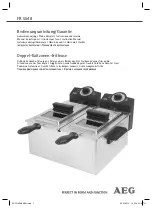
PNEUMATIG.EU - GDYNIA UL.WIELKOPOLSKA 158 -
58 622 49 22
Technical description
DRYPOINT® RA 3-160
23
12 Technical description
12.1 Control panel
The control panel explained below is the only dryer user interface.
DRYPOINT RA 3 - 40
DRYPOINT RA 55 - 160
K
1
2
3
P
Q
S
0
00
3
DMC14
1
0
K
I
ON
1
3
set
DMC14
°C
esc
°F
2
P
Q
S
00
0
4
1
Main switch
3
Air and refrigerant gas flow chart
2
DMC 14 electronics
12.2 Functional description
Operating principle
– All dryer models described in this manual function according to the same principle. The hot and
moisture-loaded air is led into an air/air heat exchanger. Afterwards, the air flows through an evaporator, which is also
known as an air/refrigerant heat exchanger. The air temperature is reduced to approximately 2°C, so that water vapour
condenses to liquid. The continuously accumulating condensate is collected in the separator to be discharged via the
condensate drain. Subsequently, the cold and dry air is led through the air/air heat exchanger, so that it is reheated to
up to 8°C below the inlet temperature when leaving the dryer.
Refrigeration cycle
– The refrigerant is conducted through the compressor and reaches a condenser under high pres-
sure. There, cooling-down takes place, making the refrigerant condense to a liquid state which is under high pressure.
The liquid is pressed through a capillary tube where the resulting pressure drop ensures that the refrigerant evaporates
at a defined temperature. The liquid refrigerant which is under low pressure is led into the heat exchanger, where it ex-
pands. The cold resulting from the expansion serves to cool down the compressed air in the heat exchanger. During this
process, the refrigerant evaporates. The low-pressure gas is resupplied to the compressor, where it is compressed
again. It then re-enters the cycle. In phases of a reduced compressed-air load, the excess refrigerant is resupplied
automatically to the compressor via the hot gas bypass valve.
PNEUMATIG
















































